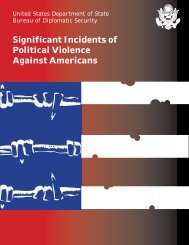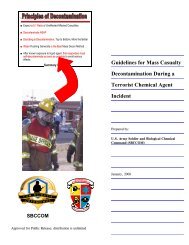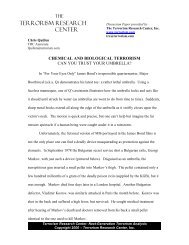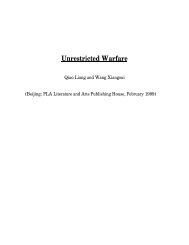Combating Proliferation of Weapons of Mass Destruction
Combating Proliferation of Weapons of Mass Destruction
Combating Proliferation of Weapons of Mass Destruction
Create successful ePaper yourself
Turn your PDF publications into a flip-book with our unique Google optimized e-Paper software.
sides bring discrete skills and abilities to the table and each can work within the existinglegal framework to improve coordination and information sharing regarding the significantthreat <strong>of</strong> the proliferation <strong>of</strong> weapons <strong>of</strong> mass destruction.Toward this end, the Department <strong>of</strong> Justice and the CIA established the Joint IntelligenceCommunity-Law Enforcement Task Force (JICLE), which recommended procedures andpolicies for appropriate coordination between the two entities. This task force identified alack <strong>of</strong> coordination regarding the use <strong>of</strong> intelligence crime reports or tips and leadsprovided to law enforcement by the Intelligence Community. There are concerns within thelaw enforcement community that the IC is not forthcoming with information it can sharewithout risk to sources and methods. In addition, there are continuing problems, bothcultural and legal, with sharing <strong>of</strong> law enforcement information with the IntelligenceCommunity. While some <strong>of</strong> these problems transcend proliferation, the potential harm fromproliferation and, worse, use <strong>of</strong> weapons <strong>of</strong> mass destruction is so great that solutionsmust be identified, implemented and maintained.Recommendation 5.29: The National Director should coordinate efforts toimprove the relationship <strong>of</strong> the Intelligence Community and law enforcement intheir respective efforts to detect, disrupt, prevent, and prosecute those who seekto acquire or use weapons <strong>of</strong> mass destruction.First, the national security agencies and domestic law enforcement agencies should bebrought together in a dialog to identify all resources within the intelligence and lawenforcementcommunities that can be brought to bear on the detection and prevention <strong>of</strong>the acquisition or use <strong>of</strong> weapons <strong>of</strong> mass destruction. Next, guidelines should beestablished identifying what information, intelligence and investigative, can be shared andunder what circumstances, rather than only specifying what cannot be shared. Also,processes should be put in place for the appropriate exchange <strong>of</strong> information from theoperational units <strong>of</strong> each community and for monitoring the effectiveness <strong>of</strong> such sharing.Lastly, a joint Intelligence Community/law enforcement report should be submitted to theAttorney General and to the Director <strong>of</strong> Central Intelligence, outlining steps taken toestablish information sharing procedures, and detailing examples <strong>of</strong> such sharing as itrelates to combating proliferation.The Department <strong>of</strong> Justice is the initial law enforcement and prosecutorial contact pointwith the IC, and thus should be an important part <strong>of</strong> the assessment process. DoJ shouldestablish specific procedures by which the sharing <strong>of</strong> information between the IC and lawenforcement can be monitored, and should regularly communicate with the IC regardingthe results <strong>of</strong> the information sharing.DoJ should actively encourage such sharing by providing advice to the law enforcementcommunity as to when and what information can and should be shared with the IC, e.g.,82







